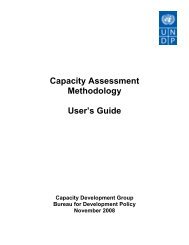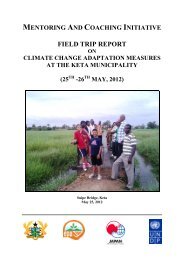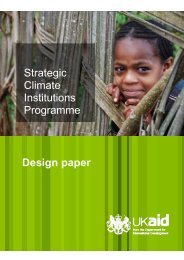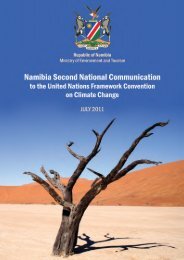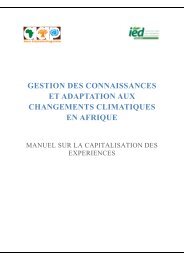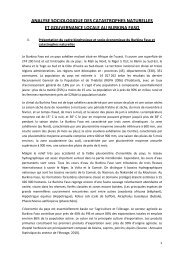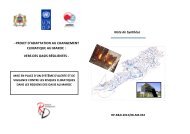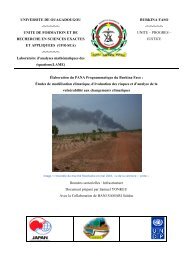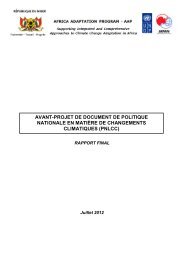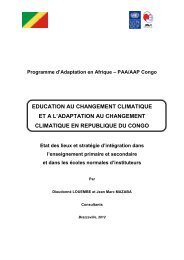Handbook of Capitalisation 2012.pdf - Africa Adaptation Programme
Handbook of Capitalisation 2012.pdf - Africa Adaptation Programme
Handbook of Capitalisation 2012.pdf - Africa Adaptation Programme
You also want an ePaper? Increase the reach of your titles
YUMPU automatically turns print PDFs into web optimized ePapers that Google loves.
<strong>Africa</strong> <strong>Adaptation</strong> <strong>Programme</strong><br />
<strong>Handbook</strong> on <strong>Capitalisation</strong> <strong>of</strong> Experiences 2012<br />
Table 7: Project description matrix applied to the National Climate Change Coastal <strong>Adaptation</strong> Strategy<br />
<strong>Programme</strong>, Tunisia<br />
Steps/<br />
components<br />
Strategy/<br />
Approach<br />
Activities<br />
Technical/<br />
organisational<br />
processes<br />
Results/<br />
achievements<br />
Challenges met<br />
Unintended<br />
effects (positive<br />
or negative)<br />
Key questions<br />
How was the<br />
experimental<br />
project<br />
implemented?<br />
What has been<br />
done?<br />
Who are<br />
the actors,<br />
projects<br />
implementers,<br />
and partners<br />
<strong>of</strong> this<br />
experience?<br />
What are the<br />
outcomes<br />
stemming<br />
from the<br />
experience?<br />
What<br />
challenges<br />
have been<br />
met? What<br />
solutions have<br />
been tested?<br />
What has<br />
happened<br />
that was not<br />
expected?<br />
Project start<br />
Problem statement and needs expressed by national partners<br />
Establishing a technical committee to facilitate the<br />
implementation <strong>of</strong> this activity<br />
Kick-<strong>of</strong>f meeting<br />
Consultation meetings with stakeholders involved, data<br />
collection, submission <strong>of</strong> draft document for review and<br />
comment by the ministries and technical departments involved<br />
Approval <strong>of</strong> the document by all partners in the first phase and<br />
start <strong>of</strong> the second phase with a workshop involving the entire<br />
COPIL.<br />
Confirmation <strong>of</strong> the need to develop a national CC coastal<br />
adaptation strategy<br />
Preparation <strong>of</strong> terms <strong>of</strong> reference to contract a consulting firm to<br />
develop the strategy<br />
Signing the contract with the consulting firm selected<br />
Protection Agency and Coastal Management; General<br />
Directorate for the Environment and Quality <strong>of</strong> Life; Ministry <strong>of</strong><br />
Public Works and Housing; Meteorological Institute; INSTM;<br />
DGSAM; to be completed<br />
How was implementation organized? What technologies were<br />
used?<br />
Kick-<strong>of</strong>f meeting<br />
Consultation meetings with stakeholders involved, data<br />
collection, submission <strong>of</strong> draft document for review and<br />
comment by the ministries and technical departments involved,<br />
meeting to present the first phase draft document <strong>of</strong> the<br />
strategy to finalize the current status review.<br />
Approval by all partners <strong>of</strong> the first phase document and second<br />
phase launched with a workshop involving the entire COPIL.<br />
Building a trust relationship between members and the COPIL<br />
and APAL<br />
Willingness to integrate the experimental project and to keep on<br />
forming part <strong>of</strong> the project even in the implementation phases<br />
The Ministry <strong>of</strong> Environment was not convinced <strong>of</strong> the necessity<br />
<strong>of</strong> this strategy<br />
The first phase <strong>of</strong> the strategy has led to the formulation <strong>of</strong> a<br />
vulnerability matrix that points out vulnerable areas according<br />
to the natural environment in coastal areas and islands. This<br />
allowed the small technical committee to identify two areas<br />
considered as highly vulnerable for which a CC adaptation<br />
mainstreamed ICZM Plan should be formulated. These plans will<br />
be implemented in the context <strong>of</strong> other APAL initiatives currently<br />
underway.<br />
Note: This example is fairly synthetic, for illustration purposes. In a real situation, the presentation should be more detailed.<br />
Reminder: For each axis: it is necessary to identify the sources <strong>of</strong> information and choose the appropriate collection<br />
tools. One can thus combine individual interviews with project staff, focus group discussions or interviews with the local<br />
community, etc.<br />
38



